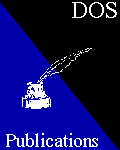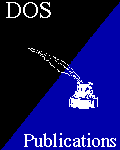
DOS
Betamax's
DOS PUBLICATIONS
UTILITIES


|
|
Doctor DOS Betamax's |
DOS PUBLICATIONS
|
The following presents books about DOS utilities such as data
compression, data recovery, and memory management,
among additional topics. Realise that books in other
categories may contain these topics as well.
INFORMATION AND IMAGES BELOW MAY NOT BE
REPRODUCED WITHOUT PERMISSION FROM THE AUTHOR ©

 |
The Data Recovery Bible 1993 by Pamela Kane ISBN: 1-56686-080-6 A human-error and virus-prevention guide, this book gives a detailed look at the pitfalls that can befall a computer owner and what to do about them. Prevention is first in Pamela's method to trouble-free computing. Each aspect of likely problems is carefully discussed and laid out for the reader. The under-workings of DOS are discussed and how they relate to the error messages regarding file storage and other operations. Then a detailed troubleshooting step-by-step is given to assist the reader. The books finishes up with a list of DOS viruses (many of which still lurk on discs and the Internet), suggested software, and a glossary. A must book for anyone that wants to know more detail on how DOS works with files and how malware (and mal-users!) can affect its usage. |
|
DOS Power Tools 1988 by Paul Somerson ISBN: 0-553-34526-5 An excellent book that gives a great deal of information on DOS development, how it works, and its implementation. There are also sections on batch techniques and DOS command tips, plus a wealth of utilities on the accompanying disc that are still very useful to the DOS afficiando. |
 |
 |
Dr. File Finder's Guide to Shareware 1990 by Mike Callahan and Nick Anis ISBN: 0-07-881646-76 A wonderful, detailed guide to shareware and freeware is presented in this book. It is well organised into categories, but also includes tips, information on DOS, troubleshooting modems and hard drives, and personal observances based on extensive experience. The included disc has many popular software programs. A recommended publication! |

 |
The First Book of Norton Utilities 1991 by Joseph Wikert ISBN: 0-672-27308-X Picking up where DOS left off is how this book starts. Although this is diluted by modern DOS versions and by myriads of utilities for DOS now available, Norton Utilities are still very usable in the 21st century. Covered here in detail is each utility of Version 5, but this book is mainly recommended for its lengthy treatment of the Norton Commander for those using point & click shells over top of DOS. |

 |
Hard Disk Management with MS-DOS and PC-DOS 1987 by Dan Gookin and Andy Townsend ISBN: 0-8306-0697-1 This book gives basics on magnetic disc storage that is still relevant today. Preparation of a hard drive is discussed including partitioning, formatting and installing DOS. Then it goes on to talk about files, directories and paths before discussing DOS batch files and menu systems. The book finishes out with disc security and optimisation. Appendices include DOS and EDLIN commands. |
|
Hard Disk Quick Reference 1989 by PD Moulton and Timothy Stanley ISBN: 0-88022-443-6 Here is an excellent, short reference book suitable for beginners. It covers hard drive basics, directory organisation (with sample structures) and file management. Also covered are backups and drive maintenance, and it has a great little section on batch files. Bonuses are AUTOEXEC.bat and CONFIG.sys command descriptions, DOS commands, error messages, command-line editing. Also included is a list of shareware and freeware - much of which should still be available today via the Internet. |
 |

 |
Inside the PC 1997 by Peter Norton and John Goodman ISBN: 0-672-31041-4 (Seventh Edition) An indispensable book regardless of what version you find. This edition details the workings of the PC in great death. As such, it is aimed at the advanced user, although intermediates would still get much out of it. Whether you use DOS, Linux, OS/2, Unix or Windows, one can find useful information here. Included are discussions on the Internet, Firewire, SCSI, USB and MMX, and the future of computing. A must read for anyone that wants to know more about his PC and the role it plays. |
|
Iomega Drivers for DOS 1991 by ? Book ID: EN 004-200 A manual for those using Bernouli drives specifically, and for anyone using zip (cartridge) drives in general, this booklet is a handy reference. It shows how to set up an Iomega disc system, how to format the discs, how to make them bootable, and how to integrate with DOS. Instructions are given for incorporating the system into a networked setup. RCD (Removable Cartridge Drive) utilities are discussed in detail. The book's lie-flat, spiral binding is a boon to those working and following along with the book at the same time. |
 |

 |
Managing Memory with MS-DOS 6 1993 by Dan Gookin ISBN: 1-55615-545-X (Second Edition) A book for the intermediate or advanced user, Dan surveys the various types of memory and how your computer uses it. He spells out many methods for optimising memory (both automatically and manually) and then discusses RAM drives and disc caching. A chapter is devoted to after-market managers, and then setup scenarios are discussed. A glossary rounds out this very useful book. |
|
Memory Management and Multitasking Beyond 640K 1992 by Lenny Bailes and John Mueller ISBN: 0-8306-3476-2 Although less relevant today with so much automated memory management, this book provides a great deal of background information on how computer memory works and then goes on to explain DOS usage of it. Geared toward intermediate and advanced users of MS or DR DOS (Dee-Are DOS), their included memory management is discussed along with programs that make usage of memory beyond 640K. After-market managers are discussed along with task switching and multitasking in the DOS environment. An entire chapter is devoted to DESQview and DESQview-X. Finally, there are chapters discussing OS/2 and Windows. A disc is included. |
 |
 |
MS-DOS Shell 1989 from NCR ISBN: ? This is an NCR manual that comes with their version of MS-DOS 4.01. Generally, manuals are not included here but it is because of its detailed description of DOS SHELL, a GUI interface for DOS. This 100+-page booklet explains everything about the shell: setting it up, adjusting preferences, program starting and grouping, file associations, display windows, and so on. This is a valuable reference to anyone using DOS SHELL. |

 |
The Norton Trouble Shooter 1988 by JJ Schoch ISBN: ? An older book, but one that still holds valuable information for those wishing to recover data. It discusses bad file and directory entries, tree structure problems, and partition and FAT problems. Each is given suggested solutions using Norton Utilities. Additionals include sections on DOS and CHKDSK error messages, and ones showing byte usage for the boot record, directory entries, file attributes, etc. |
|
The Norton Utilities 1991 by John Viescas ISBN: 1-55615-967-8 (Second Edition) Newer versions of Norton Utilities are available, but this book is an agreeable, fast reference to each one available at that time (Version 5). Each utility is listed in alphabetical order with a one-to-five-page explanation and switches usage. The book finishes up with appendices on Recovery Scenarios, Batch Enhancer Menu System, BEEP Frequencies, and Colour Names and Codes. A nice, fast review for users of Norton Utilities. |
 |
 |
Norton Utilities 5 1991 by Michael Gross ISBN: 0-89588-737-1 A book similar to above but it covers both Versions 4.5 and 5. This has an introduction to using Pull-Down Menus, List and Dialog Boxes, Toggle and Radio Buttons, and using Prompts. Then each utility is listed by alphabetical section with an explanation regarding difference between the 4.5 and 5 versions. A how-to format of using that particular utility for various purposes is then laid out. |
|
Norton Utilities 6.0 1992 by Richard Evans ISBN: 0-83063-858-X This is a more in-depth book as compared to the "quick reference" ones above. Plain instructions and screen shots aid the user in implementing very some powerful commands. Also included is a discussion of NDOS, Norton's licensed version of 4DOS, a COMMAND.com replacement that can do what COMMAND.com can not. |
 |

 |
Paul Mace Guide to Data Recovery 1988 by Paul Mace ISBN: 0-13-654427-4 Step by step instructions take one through the process of getting back files on a DOS system. Problems are presented in alphabetical order, and there is a pull-out fast guide. Although an older book, many of the techniques are still valid, and at a minimum, it will come in handy if an old backup file on a floppy disc can't be read. Also discussed are ways to restore DOS spreadsheet and database files. |
|
PC Tools Data Recovery and DOS Utilities 1989 from Central Point ISBN: ? An actual PC Tools manual, it is being included here because PC Tools can be found on the Internet and in many used software places. Although written for initial versions of the utilities package, it still provides lots of useful information that can be projected to later versions. |
 |
 |
PKZIP 2 1992 from PKWARE ISBN: ? Even though improved compression methods exist, PKZIP or its equivalents are ingrained in the culture of computers. It is so dependable and accurate that I use PKZIP for all my backups, file transfers among removable media, Internet webpage file updates, and all e-mail attachments consisting of multiple files. A manual from the manufacturer, this book is included here because so few publications exist on this de-facto standard for data compression. It covers all the aspects of PKZIP and PKUNZIP, as well as PKSFX and data encryption. Some of the switches (options) could be better explained, but anyone that wants to use or gain more power via PKZIP should have this book. |
|
Power DOS! 1993 by Alfred Glossbrenner ISBN: 0-679-73924-6 A well-written, in-depth book about DOS. This has something for any DOS user regardless of skill level. It also includes computer basics, with many tips for better operation and suggestions for saving money. Many software add-ons are discussed in depth and how they can be incorporated into the DOS user's toolbox. Another must-have book for your DOS library. |
 |

 |
Quarterdeck QEMM 8 1995 by Multiple Authors and Editors ISBN: ? A manual from Quarterdeck, the makers of the popular memory management software. This details the installation, setting up, usage and diagnosis of QEMM version 8. This book is recommended for anyone using QEMM, even other versions, because what is here can teach the user a wealth about memory managing his DOS setup to obtain its maximum performance. |
|
Que's Speed Up Your Computer Book 1992 by Davie Reed and Barry Nance ISBN: 0-88022-761-3 This may not seem to be a useful book when one considers today's gigahertz processors, but it is still relevant because the methods and tips presented here can still be of use to anyone wanting better performance from one's hardware or even one's self - especially if using an older system. Productivity gains often come from your ability to work faster with your computer, not from the electronics. At the least, the information given is an excellent background into how computers and their components work and how they all interact. A final section discusses in detail some add-on software that will boost performance for those using older systems. |
 |

 |
Stupid PC Tricks 1991 by Bob LeVitas and Ed Tittel ISBN: 978-0201577594 A short (~150-pages) book that discusses the fun shareware that appears on the enclosed floppy disc. Included in the 17 programs are ones that display fireworks, spira-graphic line drawings, thoughts of the day, or kaleidoscopic or fractal images. Also included are screen blankers, a dice game, bugel calls and other PC speaker sounds. There are even several programs designed to play screen or speaker tricks on unsuspecting friends and coworkers. The book then has a chapter on managing TSRs, and it ends with a glossary. All programs are on the enclosed disc. Installation instructions are provided, as are methods to either amuse or aggravate friends and co-workers. |

 |
Using QEMM 1994 by Phillip Robinson ISBN: 1-55828-349-8 (Second Edition) A great book for users of Quarterdeck's QEMM, considered by many to be one of the best DOS memory managers ever. Shows how to improve DOS performance and that of its programs, and how to solve software/hardware conflicts. Although only covering up to Version 7, this is still a very valuable publication even for users of later versions. |

 |
Welcome to... Memory Management: From Mystery to Mastery 1994 by Phillip Robinson ISBN: 1-55828-343-9 Another book by Phillip Robinson for those wanting to know more about managing memory. This one is more general than Using QEMM (see farther back), but it describes the various types of memory and memory utilities - both those that come with DOS and after-market ones. The latter include QEMM, 386Max and Netroom. Then he moves on to how to use those utilities to get the best performance from your system. As an extra, Phillip discusses memory as it pertains to Macintosh, OS/2, Unix and Windows. This is a recommended book for an all-round overview of memory for the beginner, but a more in-depth look for the intermediate or advanced user. |

 |
Zip Bible: A Complete Guide to Data Compression Utilities 1996 by Itsok Kespret ISBN: 1-55755-305-X Illustrated, step-by-step instructions show the user how to make the most from data compression. Has the "Zipper's Top Ten Questions". An included disk has eight popular shareware products for DOS and Windows. |
|
Zipping for Beginners 1996 by ? ISBN: 1-55755-306-8 A basic book that walks the user through the ins and outs of data compression starting with what a zip file is. It then goes on to give examples of the operations for the most common compression tasks using PKZIP and WinZip. These include multiple-file zipping, spanning discs, self-extracting archives, and viewing the compressed file, plus all their relevant unzipping methods. A disc is included with shareware versions of each program. |
 |
A special thankyou to Colin Conrad and Babs Walker of
Dartmouth, Nova Scotia for book cover scanning work.
Thanks to Richard Bonner of Dartmouth, Nova Scotia
for digital "repairs" to the covers.
Be sure to check
DOS Websites
for links to some of the programs
mentioned in this publications reference.
|
Return to the Books Table of Contents |
Return to the Publications Table of Contents |

|
|